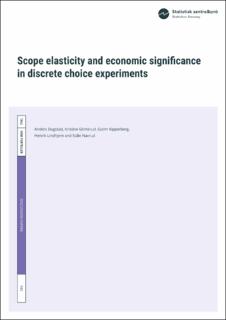| dc.contributor.author | Dugstad, Anders | |
| dc.contributor.author | Grimsrud, Kristine | |
| dc.contributor.author | Kipperberg, Gorm | |
| dc.contributor.author | Lindhjem, Henrik | |
| dc.contributor.author | Navrud, Ståle | |
| dc.date.accessioned | 2020-11-16T10:05:22Z | |
| dc.date.available | 2020-11-16T10:05:22Z | |
| dc.date.issued | 2020-11 | |
| dc.identifier.issn | 1892-753X | |
| dc.identifier.uri | https://hdl.handle.net/11250/2687986 | |
| dc.description.abstract | Sensitivity to scope in nonmarket valuation refers to the property that people are willing to pay more for a higher quality or quantity of a nonmarket public good. Establishing significant scope sensitivity has been an important check of validity and a point of contention for decades in stated preference (SP) research, primarily on contingent valuation. Recently, researchers have begun to differentiate between statistical and economic significance. This paper contributes to this line of research by studying the significance of scope effects in discrete choice experiments (DCE) using the scope elasticity of willingness-to-pay (WTP) concept. We first formalize the scope elasticity concept in a DCE context and relate it to economic significance. Next, we review a selection of DCE studies from different fields and derive their implied scope elasticity estimates. We observe that scope tests as validity checks are uncommon in the DCE literature. Most studies assume unitary elastic scope sensitivities by employing linear functional forms, and when more flexible specifications are employed, the tendency is towards inelastic scope sensitivity. Then, we apply the scope elasticity concept to primary DCE data on people’s preference for expanding the production of renewable energy in Norway. We find that all scope elasticity estimates are statistically significant and vary between 0.18 and 0.46, depending on attribute analyzed, model specification, geographic subsample, and unit of measurement chosen for a key attribute. While there is no strict, universally applicable benchmark for determining the economic significance of scope impacts, we deem these estimates to be of an adequate and plausible order of magnitude. Implications of the results for future DCE research are provided. | en_US |
| dc.language.iso | eng | en_US |
| dc.publisher | Statistisk sentralbyrå | en_US |
| dc.relation.ispartofseries | Discussion Paper;No. 942 | |
| dc.rights | Attribution-NonCommercial-NoDerivatives 4.0 Internasjonal | * |
| dc.rights.uri | http://creativecommons.org/licenses/by-nc-nd/4.0/deed.no | * |
| dc.subject | Discrete choice experiments | en_US |
| dc.subject | Scope sensitivity | en_US |
| dc.subject | Willingness-to-pay | en_US |
| dc.subject | Scope elasticity | en_US |
| dc.subject | Economic significance | en_US |
| dc.title | Scope elasticity and economic significance in discrete choice experiments | en_US |
| dc.type | Working paper | en_US |
| dc.source.pagenumber | 40 | en_US |
| dc.relation.project | Norges Forskningsråd: 267909 | en_US |
| dc.relation.project | Norges Forskningsråd: 255777 | en_US |

